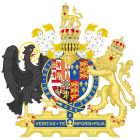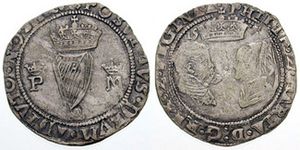Treason Act 1554 facts for kids
| Act of Parliament | |

|
|
| Long title | An Acte wherby certayne Offences bee made Treasons; and also for the Government of the Kinges and Quenes Majesties Issue. |
|---|---|
| Citation | 1 & 2 Ph. & M. c. 10 |
| Territorial extent | |
| Dates | |
| Repealed | July 30, 1948 |
| Other legislation | |
| Repealed by | Statute Law Revision Act 1948 |
| Relates to |
|
|
Status: Repealed
|
|
| Text of statute as originally enacted | |
The Treason Act 1554 was an important law made by the Parliament of England. It was passed in 1554, during the time of Queen Mary I. This law made certain actions against the King and Queen illegal. These actions were called "treason."
This Act is different from two other laws about treason passed in the same year. Those other laws were 1 & 2 Ph & M c 9 and 11.
Contents
What the Law Was About
The full name of this law was "An Acte wherby certayne Offences bee made Treasons; and also for the Government of the Kinges and Quenes Majesties Issue."
Part of this long name was removed on July 30, 1948. This happened because of another law called the Statute Law Revision Act 1948.
Protecting King Philip
This law was created to protect King Philip. He had married Queen Mary I on July 25, 1554. After their marriage, Philip became a co-ruler of England and Ireland.
The Act made it a crime to try to remove King Philip from his royal position. It was also illegal to try to harm him or the Queen. Starting a war against them in England was also against this law. Saying that the King should not have his title was also a crime.
If someone did this for the first time, they would lose their belongings. They would also be put in prison forever. If they did it a second time, it was considered a very serious crime called "high treason." However, planning to kill the King was always high treason, even for a first offense.
The Act also said what would happen if Queen Mary died. If her heir (the next in line to the throne) was a boy under 18 or a girl under 15 and not married, King Philip would rule. He would govern until the heir was old enough or married. Trying to remove King Philip from this role would also be treason.
How Trials Worked
Section 7 of the Act said that trials for treason must follow the usual common law rules. This meant trials had to be fair and proper.
Keeping Treason a Secret
Section 8 of the Act talked about "misprision of treason." This meant knowing about treason but keeping it a secret. If you knew about treason and did not tell anyone, it was a crime. However, it was not as serious as treason itself. People who did this would be punished, but not as severely as those who committed treason.
Provided always, and be it declared and enacted by the authority aforesaid, that concealment or keeping secret of any high treason be deemed and taken only misprision of treason, and the offenders therein to forfeit and suffer, as in cases of misprision of treason hath heretofore been used; any thing above mentioned to the contrary notwithstanding.
More About Trials
Section 9 protected the right of important people, called peers, to be tried by other peers. This is known as privilege of peerage.
Section 10 stated that if a crime under this Act was committed only by speaking words, the person had to be charged within six months.
Section 11 set a new rule for treason trials under this Act. It said that at least two witnesses had to come to court. They had to give evidence against the accused person in person. This rule applied if the witnesses were alive and in England. It did not apply if the accused person admitted guilt. This "two witnesses rule" was also used in later laws.
Helping Others Commit Crimes
Section 13 explained how people who helped others commit crimes would be punished. These people are called "accessories." An accessory would get the same punishment as the main person who committed the crime. This was true even if the accessory had never committed that crime before.
When the Law Ended
Most of the Treason Act 1554 was removed on July 28, 1863. This happened because of the Statute Law Revision Act 1863.
The entire Act was finally removed by the Criminal Law Act 1967.
The Law in Ireland
The Parliament of Ireland also adopted this law in 1556. This meant the law applied in Ireland too.
Other Treason Laws in 1554
| Traitorous Words Act 1554 | |
|---|---|
| Act of Parliament | |

|
|
| Citation | 1 & 2 Ph. & M. c. 9 |
| Counterfeit Coin Act 1554 | |
|---|---|
| Act of Parliament | |

|
|
| Citation | 1 & 2 Ph. & M. c. 11 |
Two other laws about treason were passed in 1554. One was called 1 & 2 Ph. & M. c. 9. It made it treason to "pray or desire that God will shorten the Queen's days."
The other law was 1 & 2 Ph. & M. c. 11. This law made it treason to bring fake coins into the country. It also changed the rules for how evidence was used in trials.
See also
- High treason in the United Kingdom
- Treason Act


